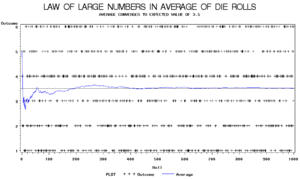Law of large numbers facts for kids
The Law of Large Numbers, often called LLN, is a cool idea from statistics. It helps us understand what happens when you do something random many, many times. Imagine flipping a coin or rolling a dice. The LLN says that if you repeat these actions a lot, the average of your results will get very close to what you expect it to be.
So, if you flip a coin 1000 times, you'll probably get close to 500 heads. The more you try, the closer your actual average gets to the true average. It's like the universe balances things out over time!
Contents
How the Law of Large Numbers Works
Let's look at an example with a standard six-sided dice. When you roll a dice, you can get a 1, 2, 3, 4, 5, or 6. Each number has an equal chance of appearing.
The average result you would expect from rolling a dice many times is calculated like this: (1 + 2 + 3 + 4 + 5 + 6) / 6 = 3.5. This "expected value" is 3.5.
At first, if you only roll the dice a few times, your average might be far from 3.5. You might roll a 6, then a 1, then a 2. But the more times you roll, the closer your average will get to 3.5. This is the Law of Large Numbers in action!
Who Discovered the Law of Large Numbers?
The idea behind the Law of Large Numbers was first described by a mathematician named Jacob Bernoulli. He thought it was so simple that anyone could understand it. Even so, it took him more than 20 years to create a strong mathematical proof for it!
He finally published his proof in a book called Ars Conjectandi (which means "The Art of Conjecturing") in 1713. Bernoulli called this his "golden theorem." For a long time, people called it "Bernoulli's theorem." (Don't mix this up with a different law in physics that has the same name!)
How the Law Got Its Name
Later, in 1835, another mathematician named Siméon Denis Poisson wrote more about this idea. He called it "la loi des grands nombres," which means "the law of large numbers" in French. After that, it was known by both names, but "the Law of Large Numbers" became the most common one.
Other Contributions to the Law
Many other mathematicians also helped make the law even better and more widely understood. Some of them include Pafnuty Chebyshev, Andrey Markov, Émile Borel, Francesco Paolo Cantelli, and Andrey Kolmogorov.
Thanks to their work, there are now two main forms of the law: the "weak" law and the "strong" law. These aren't different laws, but different ways to describe how the results you observe get closer to the actual probability. The strong form is a bit more powerful and includes the weak one.
Related pages
See also
 In Spanish: Ley de los grandes números para niños
In Spanish: Ley de los grandes números para niños


